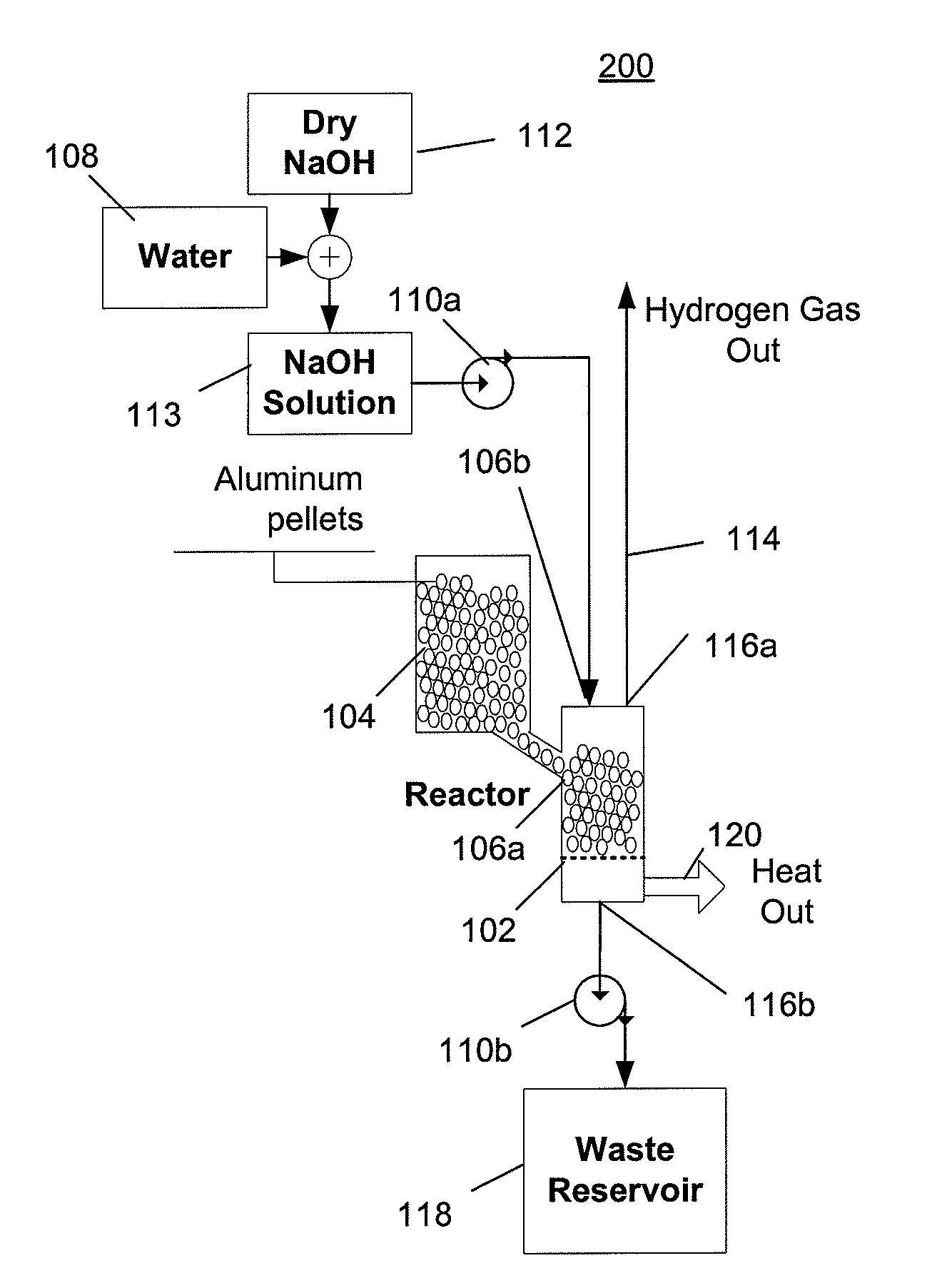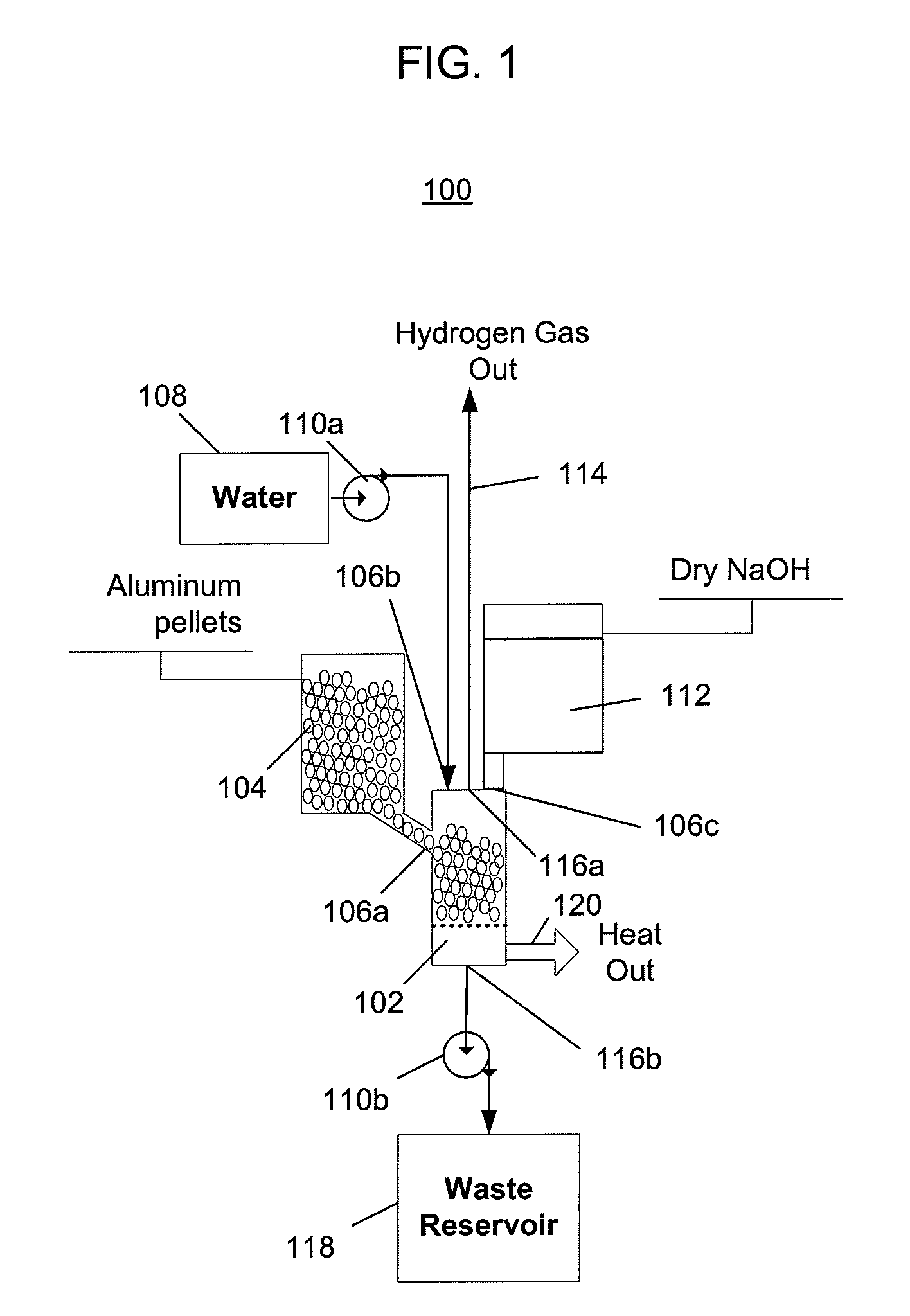Aluminum-alkali hydroxide recyclable hydrogen generator
a technology of hydrogen generator and alkali hydroxide, which is applied in the direction of electrochemical generators, machines/engines, energy input, etc., can solve the problems of little if any safety or environmental restrictions on this inert fueling mechanism
- Summary
- Abstract
- Description
- Claims
- Application Information
AI Technical Summary
Benefits of technology
Problems solved by technology
Method used
Image
Examples
first embodiment
[0050]FIG. 1 depicts a hydrogen generator 100 having a chemical reactor that receives aluminum from a first inlet, water from a second inlet, and sodium hydroxide from a third inlet, and outputs hydrogen, a waste solution, and heat. Referring to FIG. 1, the hydrogen generator 100 includes a reactor (or reaction chamber or reaction cell) 102, an aluminum source 104 that provides aluminum to the reactor via a first inlet 106a, a water source 108 and a first pump 110a that pumps water from the water source into the reactor via a second inlet 106b, and a sodium hydroxide source 112 that provides sodium hydroxide to the reactor via a third inlet 106c. The hydrogen generator 100 outputs hydrogen 114 from a first outlet 116a, and a waste solution is pumped out of a second outlet 116b by a second pump 110b into a waste reservoir 118. Heat 120 produced by the chemical reaction is not captured and is instead allowed to escape into the surrounding environment.
[0051]The configuration of the hyd...
second embodiment
[0053]FIG. 2 depicts a hydrogen generator 200 having a chemical reactor that receives aluminum from a first inlet and a solution of water and sodium hydroxide from a second inlet, and outputs hydrogen, a waste solution, and heat. The solution of hydroxide and water can be, for example, a solution of 74 grams of sodium hydroxide and 100 ml of water, which represents the practical maximum ratio of dissolved sodium hydroxide to water at room temperature. At higher temperatures, a higher ratio of sodium hydroxide to water can be used but doing so would become impractical if the solution were to cool to room temperature when crystallization of a significant quantity of the sodium hydroxide would occur, which would be undesirable. Referring to FIG. 2, the hydrogen generator 200 includes a reactor 102, an aluminum source 104 that provides aluminum to the reactor via a first inlet 106a, a water source 108 and a sodium hydroxide source 112 that provide water and sodium hydroxide that is mixe...
third embodiment
[0055]FIG. 3 depicts a hydrogen generator 300 having a chemical reactor that receives aluminum and water from a first inlet and sodium hydroxide from a second inlet, and outputs hydrogen, a waste solution, and heat. Referring to FIG. 3, the hydrogen generator 300 includes a reactor 102, an aluminum source 104 that provides aluminum to the reactor via a first inlet 106a, a water source 108 and a first pump 110a that pumps water from the water source into the aluminum source 104 via an opening 302 and a sodium hydroxide source 112 of dry sodium hydroxide that is provided to the reactor 102 via a second inlet 106b. The hydrogen generator 300 outputs hydrogen 114 from a first outlet 116a, and a waste solution is pumped out of a second outlet 116b by a second pump 110b into a waste reservoir 118. Heat 120 produced by the chemical reaction is not captured and is instead allowed to escape into the surrounding environment.
[0056]The hydrogen generator 300 of FIG. 3 can combine the aluminum a...
PUM
| Property | Measurement | Unit |
|---|---|---|
| reaction rate | aaaaa | aaaaa |
| transfer energy | aaaaa | aaaaa |
| volume | aaaaa | aaaaa |
Abstract
Description
Claims
Application Information
 Login to View More
Login to View More - R&D
- Intellectual Property
- Life Sciences
- Materials
- Tech Scout
- Unparalleled Data Quality
- Higher Quality Content
- 60% Fewer Hallucinations
Browse by: Latest US Patents, China's latest patents, Technical Efficacy Thesaurus, Application Domain, Technology Topic, Popular Technical Reports.
© 2025 PatSnap. All rights reserved.Legal|Privacy policy|Modern Slavery Act Transparency Statement|Sitemap|About US| Contact US: help@patsnap.com



